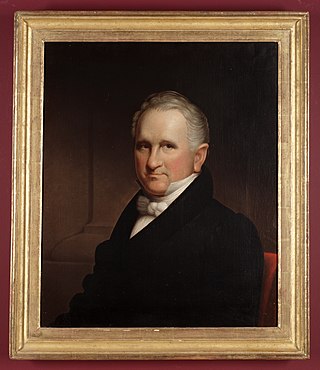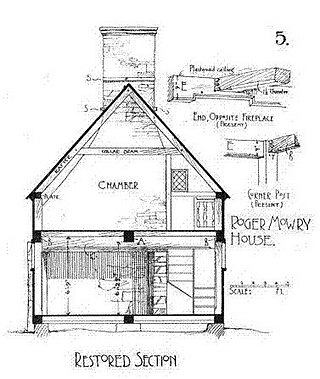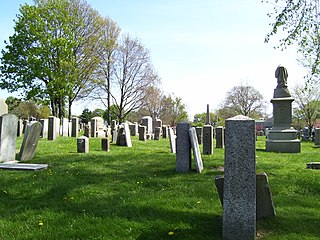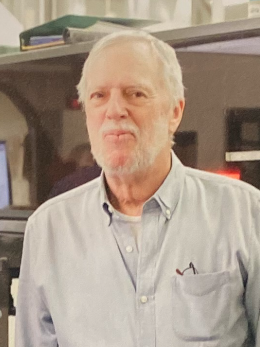
Cephas Thompson was a successful, largely self-taught, early nineteenth-century itinerant portrait painter in the United States. He was born, died, and lived most of his life in Middleborough, Massachusetts, but traveled extensively down the Atlantic coast and lived far from home for months at a time while pursuing his career as a portraitist.

Ye Antientist Burial Ground is a cemetery in New London, Connecticut, bounded by Hempstead Street on the west and Huntington Street on the east, running from Granite Street to approximately Bristol Street. It has been known by several names over the years, many spelling variations on Ancient Burial Ground. It is one of the earliest graveyards in New England and the oldest colonial cemetery in New London County. The hillside lot of 1.5 acres and adjoins the site of New London's first meeting house. The settlement at the time was called "Pequot Plantation" until the name changed in 1658. From the burial grounds, the visitor has a broad view to the east of the Thames River and, on the far shore, the heights of Groton, Connecticut.

John Axel Prip, also known as Jack Prip (1922–2009), was an American master metalsmith, industrial designer, and educator. He was known for setting standards of excellence in American metalsmithing. His works and designs have become famous for bringing together the formal, technical tradition of Danish design into harmony with the American desire for innovation. Several of his designs for the Reed and Barton Company are still in production today.

The Museum of Art, Rhode Island School of Design is an art museum integrated with the Rhode Island School of Design, in Providence, Rhode Island, US. The museum was co-founded with the school in 1877. It is the 20th-largest art museum in the United States, and has seven curatorial departments.

John Maeda is a Vice President of Design and Artificial Intelligence at Microsoft. He is an American technologist and designer whose work explores where business, design, and technology merge to make space for the "humanist technologist."

Norman Morrison Isham (1864–1943) was a prominent architectural historian, author, and professor at Brown University and Rhode Island School of Design (RISD). He was an ardent preservationist and a pioneer in the study of early American architecture.

The Common Burying Ground and Island Cemetery are a pair of separate cemeteries on Farewell and Warner Street in Newport, Rhode Island. Together they contain over 5,000 graves, including a colonial-era slave cemetery and Jewish graves. The pair of cemeteries was added to the National Register of Historic Places as a single listing in 1974.

John Everett Benson, known as Fud, is an American calligrapher, stonecarver and typeface designer who has created inscriptions for monuments including the John F. Kennedy memorial at Arlington National Cemetery, the National Gallery of Art, the Franklin Delano Roosevelt Memorial, and the Vietnam Memorial in Washington, DC.

Richard Mead Atwater Benson was an American photographer, printer, and educator who used photographic processing techniques of the past and present.

Malcolm Grear was an American graphic designer whose work encompassed visual identity programs, print publications, environmental design, packaging, and website design. He is best known for his visual identity work and designed logos for the Department of Health and Human Services, the Veterans Administration, the Presbyterian Church USA, and Vanderbilt University. He was the CEO of Malcolm Grear Designers, a design studio in Providence, Rhode Island.

Nicholas Waite "Nick" Benson is a third generation American stone carver, stone letterer and owner of The John Stevens Shop in Newport, Rhode Island. He was named a 2010 MacArthur Fellow.
John Hegnauer is an American stone carver.

Rosanne Somerson is an American-born woodworker, furniture designer/maker, educator, and former President of Rhode Island School of Design (RISD). An artist connected with the early years of the Studio Furniture, her work and career have been influential to the field.
Timeline of Newport, Rhode Island.

Funerary art in Puritan New England encompasses graveyard headstones carved between c. 1640 and the late 18th century by the Puritans, founders of the first American colonies, and their descendants. Early New England puritan funerary art conveys a practical attitude towards 17th-century mortality; death was an ever-present reality of life, and their funerary traditions and grave art provide a unique insight into their views on death. The minimalist decoration and lack embellishment of the early headstone designs reflect the British Puritan and Anglo-Saxon religious cultures.
Andrew Stein Raftery is an American artist and educator, known for his paintings, burin engravings, and drawings on fictional and autobiographical narratives of contemporary American life.

John Howard Benson was an American calligrapher, stonecarver, incised letter designer, author, and educator.

Gilbert Alfred Franklin (1919–2004) was an English-born American sculptor and educator. He was active in Providence, Rhode Island and Wellfleet, Massachusetts; and was best known for his public art sculptures.

Rhode Island Slave History Medallions, or RISHM, is a statewide non-profit organization based in Newport, Rhode Island. RISHM's mission is to raise public awareness of Rhode Island’s dominant role in the institution of slavery. RISHM marks historic sites and homes with a bronze plaque, or medallion, in communities around the state connected to slavery, to commemorate lives of the enslaved, and open a dialogue for racial understanding and healing.


















